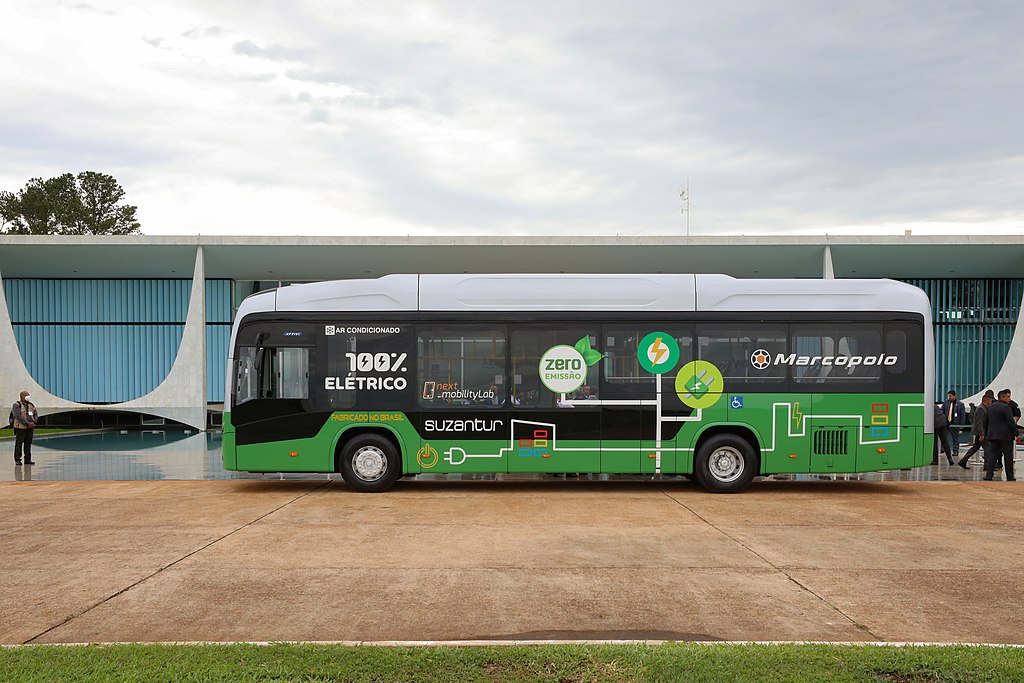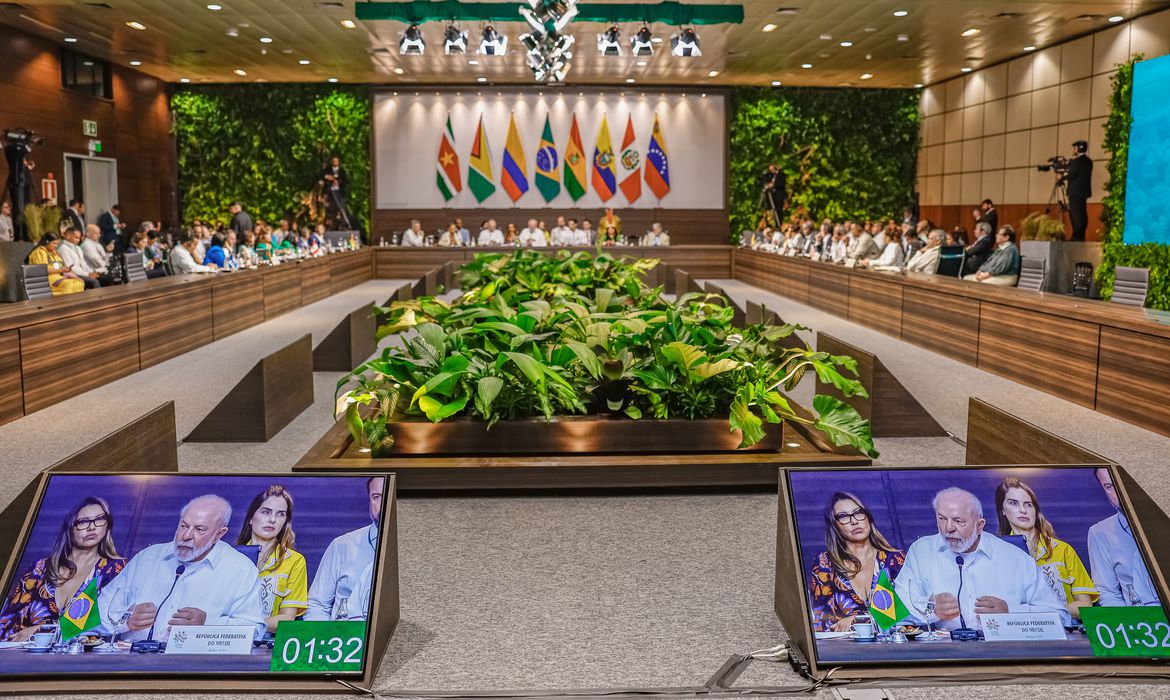
Toward electrification, Brazil prepares for the decarbonization of public transportation
A strategic plan for the gradual electrification of vehicles drives the country’s emissions-reduction outlook
Yasmin Henrique, from NINJA’s Collaborative Coverage at COP30
The electrification of the Brazilian fleet is expected to occur gradually over the decade, according to the Ten-Year Energy Expansion Plan (PDE 2032), focusing on commercial vehicles, light trucks, and urban buses. This progress is primarily driven by corporate sustainability goals and emission restrictions in urban areas.
Short-distance freight transport, especially the distribution of online orders, is expected to benefit significantly. The PDE estimates that by 2032, about 20% of new electric vehicles and 15% of semi-light and light hybrids will be dedicated to freight transport. Large companies are already adopting decarbonization measures, such as JBS, which launched No Carbon, an electric truck leasing company.
Despite the growth of the electric fleet, hybrid and natural gas-powered vehicles are expected to show even greater expansion. According to the plan, diesel will continue to predominate, representing 95% of sales until 2032. Programs like Rota 2030 and Combustível do Futuro (Fuel of the Future) maintain an emphasis on energy efficiency and low-carbon intensity biofuels, such as ethanol and biomethane.
Electrified Public Transport
Among urban vehicles, electric buses stand out as a strategic solution. According to the European Automobile Manufacturers’ Association (ACEA), the registration of zero-emission buses grew by 45% in the first half of 2024.
Advantages include: CO₂ reduction, lower operational cost — since electricity is cheaper than fossil fuels — and absence of noise. Active manufacturers in Brazil include Volvo, Mercedes, Solaris, and Irizar, with projects for long-distance routes as well.
A study conducted by ITDP, Scipopulis, and the Ministry of Cities analyzed 46,236 urban buses, with 37,395 in operation, and identified the potential to replace more than 14,146 diesel buses with electric ones, prioritizing vehicles over five years old and those with obsolete technologies (Euro III and V). The systems with the greatest potential include São Paulo, Rio de Janeiro, Goiânia, and Belo Horizonte.
The replacement could reduce 437.7 kt of CO₂e per year — equivalent to 24.6% of current emissions in the analyzed systems — and generate estimated annual savings between R$ 54.4 and 62.1 million, considering only the Social Cost of Carbon. The initiative would benefit 41% of the Brazilian population and improve 50% of the urban fleet in the 21 largest metropolitan regions.
Metro-rail systems already operate essentially on electricity. Leonardo Mandelli Valentini (Motiva), in a statement to Brasil Energia, explains that 80% of the energy is consumed by the movement of trains, and 20% by station infrastructure, which can be higher in underground stations. Improvements include optimizing train dispatch and maximizing regenerated energy during braking, thereby increasing efficiency.
Cars, Motorcycles, and Bicycles
The Gurgel Itaipú E150, launched in 1974, was the first electric car in Latin America, created during the oil crisis and the Proálcool program. With a range of 60 km and a maximum speed of 60 km/h, it served as the basis for the Itaipú E400 and marked Brazil’s pioneering role in vehicle electrification.
Today, the Brazilian market has various types of electrified vehicles: Mild Hybrid, Full Hybrid, Plug-in Hybrid (PHEV), Battery Electric Vehicles (BEV), and Fuel Cell Electric Vehicles (FCEV), each with distinct range, costs, and technologies. Between 2020 and 2023, the electric and hybrid fleet tripled, according to NeoCharge, but it still represents a small share compared to other countries, limited by high costs, lack of incentives, and dependence on imports.

Electric motorcycles are gaining ground, offering lower daily costs, silent operation, and exemption or reduction of IPVA (Vehicle Property Tax). Brands like Voltz, Super Soco, GWS, and Shineray lead the market, while traditional manufacturers like Honda and Kawasaki announce electrification plans. The electric bicycle segment is also growing rapidly: in 2024, 284,000 units were circulating in the country, compared to 7,600 in 2016, according to analysis by Aliança Bike.
Green Mobility in Brazil
The electrification of the Brazilian fleet — including buses, commercial vehicles, motorcycles, and bicycles — has great potential to reduce greenhouse gas emissions, improve air quality, decrease noise pollution, and generate positive economic and social impacts. To enable this transition, recommended actions include efficient management of operational data, implementation of compatible charging infrastructure, and coordinated public procurement among the Union, states, and municipalities, generating scale and stimulating national industry.
National Public Transportation Fund, provided for in Bill No. 3,278/2021, intended to finance electrification, the cost of free-fare policies, urban tolls, parking, and revenue from fines. aimed at financing electrification, the cost of free fares, urban tolls, parking, and fine revenues. Strategic studies, such as REFROTA and Novo PAC, define investment priorities for public policies.
Urban transport is responsible for 40% to 60% of greenhouse gas (GHG) emissions in the country, according to a study by the Coalition for Urban Transitions. According to the report by the National Electric Mobility Platform (PNME), in partnership with Addax Consulting, achieving 64% electric buses in the national fleet would require an investment of R$ 43.5 billion, would contribute to the goals of the Paris Agreement and the Zero Carbon Brazil 2060 plan, and could reduce up to 45% of greenhouse gas emissions by 2050, generating estimated social benefits between R$ 260 and 290 billion.
International investments also support the transition. Bloomberg Philanthropies, the federal government, and BTG Pactual created a fund of €80 million (~R$ 500 million) to finance electric buses, with a plan to release up to €450 million (~R$ 2.7 billion) over six years, covering 1,700 vehicles and charging infrastructure — a 235% increase over the current fleet.
The first cities to benefit will be Rio de Janeiro, Salvador, Curitiba, and Belo Horizonte. Michael Bloomberg emphasizes: “When cities, governments, and the private sector work together, we move faster in implementing climate solutions.”
Experts interviewed by Aliança Bike reinforce that the success of electric mobility depends on adequate battery recycling, clear regulation — such as UN38 standards and Inmetro certifications — and accessible national production, highlighting the importance of integrating technology, public policies, and consumer education.
For the experts, the energy transition must go hand in hand with efficient public policies, incentives for national production, and integration with active transport modes, consolidating Brazil’s role in building sustainable and low-carbon urban mobility.




